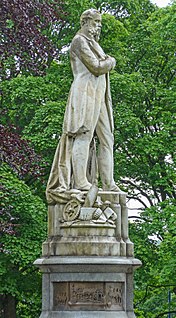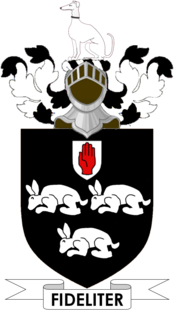
There have been two baronetcies created for persons with the surname Wynn, one in the Baronetage of England and one in the Baronetage of Great Britain. One creation is extant as of 2008.

There have been seven baronetcies created for members of the Lowther family, one in the Baronetage of Nova Scotia, two in the Baronetage of England, two in the Baronetage of Great Britain and two in the Baronetage of the United Kingdom. Two of the creations are extant as of 2008.

Baron Masham is a title that has been created three times, once in the Peerage of Great Britain and twice in the Peerage of the United Kingdom. It was first created in the Peerage of Great Britain in 1712 when the courtier Samuel Masham was made Baron Masham, of Otes. In 1723 he also succeeded as fourth Baronet of High Lever. This creation became extinct on the death of the second Baron in 1776. The Masham Baronetcy, of High Lever in the County of Essex, was created by James I Baronetage of England on 20 December 1621 for Samuel Masham. The third Baronet was Member of Parliament for Essex. The baronetcy became extinct along with the barony in 1776.

There have been three baronetcies created for persons with the surname Croft, one in the Baronetage of England and two in the Baronetage of the United Kingdom. All three creations are extant as of 2008.
There have been four baronetcies created for members of the Astley family, three in the Baronetage of England and one in the Baronetage of the United Kingdom. Only one creation is extant as of 2008. The Astley family were descended from Sir Thomas de Astley of Astley, Warwickshire, who was killed in the Battle of Evesham in 1265. He married twice. From his first marriage to Joane de Blois descended the Astley baronets of Patshull, whose family seat was at Patshull Hall, Staffordshire, and the Astley baronets of Everley, Wiltshire. From his second marriage to Editha Constable of Melton Constable, Norfolk, descended the Astley baronets of Melton Constable, the Astley baronets of Hillmorton, and the Barons Astley of Reading.
The Dudley-Williams Baronetcy, of the City and of the County of the City of Exeter, is a title in the Baronetage of the United Kingdom. It was created on 2 July 1964 for the aeronautical engineer and Conservative politician, R. Dudley Williams. On receiving the baronetcy, on 29 June 1964 Williams changed his surname to Dudley-Williams by Deed Poll. As of 2010 the title is held by his son, the second Baronet, who succeeded in 1987.
There have been two baronetcies created for members of the Ropner family, both in the Baronetage of the United Kingdom. Both creations are still extant. The Ropner family is of German descent.
There have been nine baronetcies created for persons with the surname Lloyd, three in the Baronetage of England, three in the Baronetage of Great Britain and three in the Baronetage of the United Kingdom. Two of the creations are extant as of 2010.
The Pryke Baronetcy, of Wanstead in the County of Essex, is a title in the Baronetage of the United Kingdom. It was created on 3 November 1926 for William Robert Pryke. He was Chairman of Pryke & Palmer Ltd, iron and hardware merchants, and served as Lord Mayor of London from 1925 to 1926.
There have been two baronetcies created for persons with the surname Brooks, both in the Baronetage of the United Kingdom: one creation is extant as of 2007.
There have been three baronetcies created for persons with the surname Newman, one in the Baronetage of England and two in the Baronetage of the United Kingdom. Two of the creations are extant as of 2007.

The Horlick Baronetcy, of Cowley Manor in the County of Gloucester, is a title in the Baronetage of the United Kingdom. It was created on 18 July 1914 for the pharmacist and businessman James Horlick, brother of William Horlick. He was Chairman and President of Horlicks Ltd. The fourth Baronet represented Gloucester in the House of Commons from 1923 to 1929.
The Forwood Baronetcy, of The Priory, Gateacre, in the parish of Childwall in the County Palatine of Lancaster, is a title in the Baronetage of the United Kingdom. It was created on 5 September 1895 for the Conservative politician Arthur Forwood. He was Parliamentary and Financial Secretary to the Admiralty from 1886 to 1892.
There have been two baronetcies created for persons with the surname Owen, one in the Baronetage of England and one in the Baronetage of the United Kingdom.
Cunliffe-Owen may refer to:
There have been seven baronetcies created for persons with the surname Sinclair, six in the Baronetage of Nova Scotia and one in the Baronetage of Great Britain. Four of the creations are extant as of 2008.

The Cunliffe Baronetcy, of Liverpool in the County of Lancaster, is a title in the Baronetage of Great Britain. It was created on 26 March 1759 for Sir Ellis Cunliffe, a merchant and Member of Parliament for Liverpool. The fourth Baronet was a General in the Bengal Army. The fifth Baronet represented Flint Boroughs and Denbigh Boroughs in the House of Commons.
The Smith, later Hamilton-Spencer-Smith, later Spencer-Smith Baronetcy, of Tring Park in the County of Hertford, is a title in the Baronetage of the United Kingdom. It was created on 11 June 1804 for Drummond Smith, with remainder to the heirs male of his niece Augusta, wife of Charles Smith, MP, of Suttons, Essex. The latter was a descendant of Robert Smith, of Ilminster, from whom the Smith-Marriott baronets are also descended. The fifth Baronet, was a member of the Military Inter-Allied Commission of Control from 1920 to 1924. The sixth Baronet discontinued the use of the surname of Hamilton.

There have been two baronetcies created for persons with the surname Dudley, one in the Baronetage of England and one in the Baronetage of the United Kingdom. Both creations are extinct.










